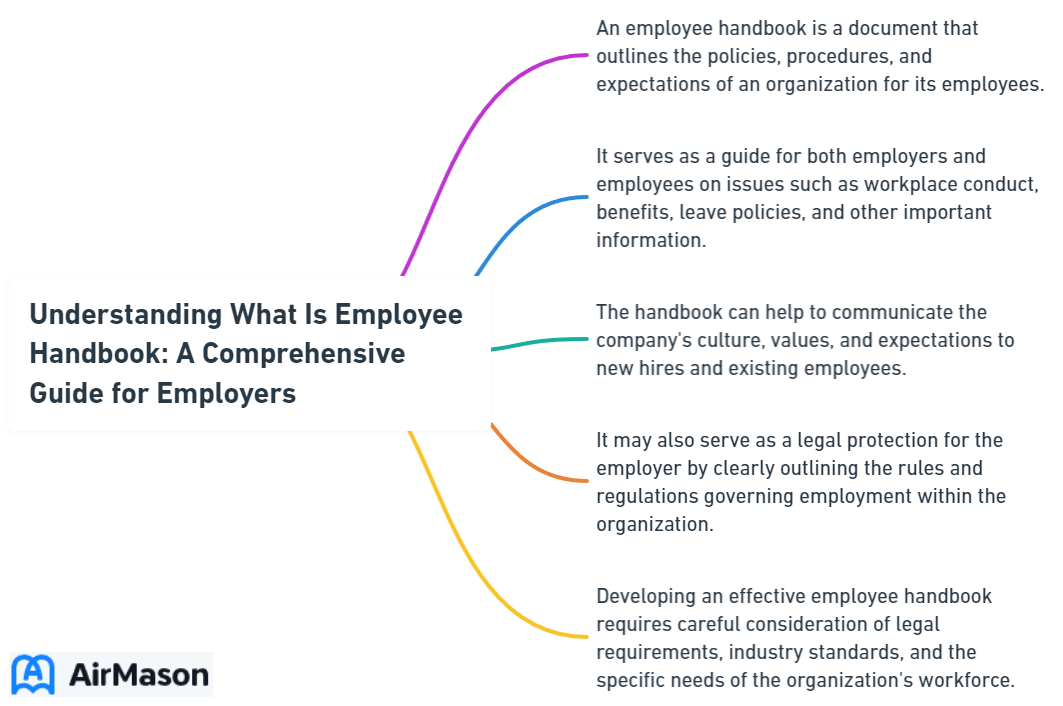
An employee handbook encapsulates the ethos of a workplace, providing structured guidance on expectations, rights, and procedures for both staff and management. It’s a vital communication tool that ensures consistency and clarity in the day-to-day operations of a company. This article answers the fundamental question: What is an employee handbook? Delving into its various components, we explain how it not only orients new hires but also reaffirms a shared understanding of “what is employee handbook” in terms of workplace culture and legal compliance for all employees.
Key Takeaways
- An employee handbook is a critical document that communicates the company’s culture, values, and procedures to new and existing employees, serving as a guide for expected behavior, legal rights, and company policies.
- Employee handbooks play a significant role in legal compliance, offering employers protection against unfair treatment claims by detailing at-will employment policies, disclaimers, and anti-discrimination laws, thereby avoiding potential litigation.
- Regular updates and accessibility of the employee handbook are imperative to ensure it reflects the most current laws, regulations, and company standards, with consideration given to both digital and print distribution for employee convenience.
Decoding the Employee Handbook

An employee handbook is much more than a set of rules or a list of do’s and don’ts. It’s a comprehensive guide that provides essential information about the company and the organization’s terms of employment. Imagine a new employee stepping into the company premises, filled with uncertainty, curiosity, and a bit of anxiety. The employee handbook serves as their first friend, introducing them to the company’s mission, vision, and values, giving them a sense of belonging, and aligning them with the company’s strategic objectives.
Moreover, the handbook is not just for new hires. It is equally relevant for existing employees, acting as a single source of truth for all company policies and procedures. By establishing clear standards and expectations, it minimizes disputes, fostering a harmonious work environment. It’s not just about rules and regulations, but about building a community with shared values and vision.
But for an employee handbook to be truly effective, it needs to strike the right tone. A professional yet approachable tone, free of legal jargon, ensures that it communicates effectively with employees. It should be a blend of professionalism and personality – reflecting the company’s character and making employees feel a part of the journey.
Employee Policies Handbook
The Employee Policies Handbook serves as a comprehensive guide outlining the expectations, rules, and regulations governing employee conduct within an organization. This handbook is designed to provide employees with clarity on various workplace policies, including but not limited to, code of conduct, disciplinary procedures, and benefits eligibility. By familiarizing themselves with the contents of the Employee Policies Handbook, employees can gain a better understanding of their rights and responsibilities in the workplace. Moreover, the handbook serves as a reference point for managers and HR personnel when addressing employee concerns or enforcing company policies. Regular updates to the handbook ensure that it remains relevant and aligned with any changes in laws or company practices, fostering a transparent and compliant work environment. Overall, the Employee Policies Handbook plays a crucial role in promoting consistency, fairness, and compliance across all levels of the organization.
The Role and Importance of an Employee Handbook
An employee handbook is not just a good-to-have document; it’s a must-have tool for every organization. It plays a crucial role in maintaining consistency in the workplace, guiding employee conduct, and minimizing operational inconsistencies. Imagine a ship without a compass or a city without signboards – that’s what a company without a documented handbook would be like.
The handbook doesn’t just align employees with the company culture; it also serves as a legal shield for employers. By making staff aware of their rights and company policies, it provides legal protection to employers.

Aligning Staff with Company Culture
The employee handbook is a cornerstone in building a cohesive corporate culture. It communicates the company’s mission, vision, and values, helping employees understand the essence of the organization. It’s like the DNA of a company, defining its identity and differentiating it from others.
It’s not just about communicating the company culture; it’s also about fostering a sense of community and shared values. The handbook encourages employees to actively participate in the company’s culture, fostering a sense of belonging. For new hires, the handbook acts as a compass, guiding them towards understanding the company’s ethos from the very beginning of their employment. Companies like HubSpot and Netflix are shining examples of how employee handbooks can effectively communicate company culture and values.
Legal Shield Against Unfair Treatment Claims
While the employee handbook serves as a guide for employees, it also provides vital legal protection to employers. It outlines employee rights and company policies, acting as a legal shield against unfair treatment claims. By including legal disclaimers and at-will policies in the handbook, a company can demonstrate its commitment to legal compliance.
The employee handbook serves multiple purposes, including:
- Establishing a mutual agreement between the employer and the employee
- Creating a mutual understanding of workplace rules and protections
- Contributing to the company’s legal shield
- Informing staff about equal employment and non-discrimination policies
- Protecting against unfair treatment based on factors like age, sex, race, religion, national origin, and disability.
Crafting Your Own Employee Handbook: Key Elements

Creating an employee handbook is not a one-size-fits-all process. A well-crafted handbook should reflect the unique characteristics and personality of your company, tailored to meet specific business needs and legal requirements. Companies like Nordstrom and Valve have set great examples by crafting handbooks that reflect their own culture and operational style.
A comprehensive employee handbook should include:
- Information about the organization’s mission and values
- Expectations for employees
- Detailed policies and procedures
- Modern aspects like remote work and health protocols
- Integration of diversity, equity, and inclusion initiatives
The content should be organized systematically with clear headings and visuals for better accessibility and understanding.
It’s not just about creating the handbook; it’s also about ensuring that employees understand and acknowledge its contents.
Policies and Procedures at the Workplace

Employee handbooks typically serve as a repository of company policies and procedures, including the organization’s policies. The employee handbook outlines general policies such as:
- dress codes
- work hours
- time-off requests
- consequences of policy violations
This ensures fairness and consistency in the workplace, reduces ambiguity, and provides a reference point for both employees and managers.
The handbook should also detail leave policies, compensation, and workplace safety measures. It should outline the accrual and scheduling of time off, paid holidays, and compliance with the Family and Medical Leave Act and other statutory leaves. By including information about compensation, such as salary hikes tied to performance, bonuses, stock options, and commission opportunities, it helps employees understand their benefits and rewards.
Addressing workplace safety includes:
- Detailing employer and employee obligations to mitigate recognized hazards
- Establishing procedures for accident reporting
- Ensuring adherence to safety regulations
These measures add another layer of protection for employees.
Behavioral Expectations and Code of Conduct

The employee handbook is a valuable tool to guide employee behavior within the organization. It outlines the company’s code of conduct, clarifying acceptable behaviors and the consequences of poor behavior to foster a respectful work environment. It’s like a roadmap, guiding employees on their journey within the organization.
The code of conduct should stipulate expectations for employee actions, including interactions, use of company property, dress code, and handling conflicts of interest, with detailed policies for each scenario. If an employee steps out of line, the handbook provides a clear outline of disciplinary measures they could face, ensuring they understand the repercussions of their actions. The key is to craft the code of conduct in a manner that is clear and understandable, steering clear of excessive legal jargon and making it accessible to all employees to foster compliance and accountability.
Benefits and Perks Information
In addition to setting expectations and outlining the code of conduct, the employee handbook also serves as a guide for benefits and perks. Some examples of benefits that should be outlined in the handbook, featuring eligibility requirements and enrollment procedures, include:
- Health insurance
- Dental insurance
- Vision insurance
- Life insurance
- Retirement plans
- Wellness programs
The handbook should also detail various perks such as parental leave and remote work stipends, providing employees with a clear understanding of their entitlements and eligibility conditions. Each policy, program, or procedure should be described in an accessible manner within the handbook, with pointers to additional documentation for more comprehensive details. By including information regarding FMLA and the accommodation of disabilities, the handbook ensures employee awareness of their legal entitlements.
Not to forget, the handbook should be regularly revised to keep benefits information up to date with the latest company practices and legal obligations.
Employee Handbook PDF
An employee handbook PDF serves as a comprehensive guide outlining company policies, procedures, and expectations. Accessible in digital format, it ensures that employees can easily reference important information anytime, anywhere. This document typically covers various aspects such as employment terms, code of conduct, benefits, and disciplinary procedures. Moreover, an employee handbook PDF fosters consistency in communication, ensuring that all staff members receive the same information. It also serves as a valuable resource for new hires, providing them with insights into the organization’s culture and values. Additionally, periodic updates to the PDF version help in keeping the workforce informed about any policy changes or updates.
Integrating New Employees with the Onboarding Process

The employee handbook plays a pivotal role in integrating new employees into the company. It acts as a welcome guide, introducing them to the company’s culture, mission, and values, fostering a sense of engagement and belonging from the onset. It’s like a mentor, guiding new hires through the onboarding process, formalizing essential employment policies and procedures, ensuring organizational consistency.
The handbook also helps new hires assimilate the company culture, advancing their connection to and understanding of their new work environment. It outlines important details for new employees, including introductory or probationary period guidelines, onboarding and orientation processes, and employment classifications, setting clear expectations.
One of the most critical parts of the onboarding process is getting the employee’s signature on the acknowledgment form, reaffirming their understanding of the handbook’s contents and commitment to the organization’s practices.
Welcome Letter and Company Overview
A welcome letter in the employee handbook helps establish a sense of belonging and enthusiasm in new hires from their first day. Authored by a company leader, the welcome letter should convey the organization’s culture and general expectations for new employees’ success. It’s like a warm handshake, welcoming the new hires into the company family.
Including a company overview in the handbook provides new employees with knowledge of the company’s journey, company values, milestones, and current market standing.
It’s like a story, narrating the company’s journey, its values, and what it stands for. A well-crafted welcome letter and company overview can set the tone for a new hire’s relationship with the company, making them feel valued and welcomed.
Understanding Employment Agreements and Practices
The employee handbook serves as a clear outline of the employment agreement and practices, setting firm expectations from the start of employment. It’s like a reference guide, providing clarity on what the company expects from the employees and what the employees can expect from the company.
Establishing clear employment practices in the handbook ensures a consistent and predictable work environment for employees. It’s like a rulebook, setting the ground rules for the workplace, ensuring that everyone is on the same page, and creating a fair and transparent work environment.
What is Included in an Employee Handbook
An employee handbook include as a comprehensive guide outlining the company’s policies, procedures, and expectations for employees. It typically covers a wide range of topics, including but not limited to, employment policies, code of conduct, benefits, compensation, safety guidelines, and disciplinary procedures. This document is essential for both employers and employees as it sets clear expectations and helps maintain consistency within the organization. Additionally, it often includes information about the company’s mission, values, and culture, providing employees with insight into the organization’s ethos. Employee handbooks also commonly feature sections on legal compliance, such as equal employment opportunity policies and harassment prevention guidelines, ensuring that the company operates within the bounds of the law and promotes a fair and respectful work environment.
Maintaining Compliance with Federal and State Laws
While employee handbooks are not mandated by law, they act as an essential resource for detailing employees’ workplace rights and the employer’s compliance with labor laws. By providing at-will protections that state employers can terminate employment at any time, the handbook serves as a protective measure for the company, preventing unnecessary litigation.
To maintain its relevance and legal integrity, the employee handbook should be regularly reviewed and updated to ensure compliance with evolving federal and state laws, industry-specific regulations, and internal standards set by the employer. The handbook should start with a disclaimer stating explicitly that it is not an employment contract to clarify its legal standing and prevent misinterpretations.
Regular Review and Updates of the Handbook
Regular reviews and updates of the employee handbook are critical to ensure it remains current with laws, regulations, and internal standards. As company culture and business practices are dynamic, handbooks need to evolve to accurately reflect any changes, including adaptations such as:
- shifts to remote work
- changes in company policies
- updates to legal requirements
- modifications to benefits and compensation
By regularly reviewing and updating the employee handbook, you can ensure that it remains a valuable resource for both informing employees and the organization as a whole.
Handbook revisions should be done as necessary to maintain compliance with HR law and to ensure that the document accurately depicts current company policies. An organized archive of previous versions of the employee handbook should be maintained for legal documentation and to oversee the evolution of company policies and procedures.
Accessibility and Distribution of the Employee Handbook
In this digital age, accessibility is key. Employee handbooks should be available in both digital and print formats, catering to diverse workforce preferences. While digital handbooks offer the convenience of portability and easy updates, printed handbooks serve as a valuable resource for those who prefer a physical document or lack access to digital means.
The distribution of the handbook is equally important, and methods can include emailing, posting on the company intranet, and presenting during orientation sessions. Whether it’s a digital copy on their mobile devices or a printed copy on their desks, every employee should have reliable access to the handbook, ensuring that they are always on the same page with company policies and procedures.
Keeping Records in the Employee’s Personnel File
Keeping a record of the employee’s acknowledgment of the handbook is a crucial part of the onboarding process. It serves as a reference in disciplinary situations, affirming that the employee was aware of the policies they are being disciplined for violating.
After obtaining the employee’s signature on the acknowledgment form, it should be securely stored in their personnel file for future reference. This ensures that both the employee and the employer have a clear understanding of the expectations and policies outlined in the handbook, leading to a harmonious work environment.
Summary
Employee handbooks are much more than a set of rules or a company document. They are a reflection of the company’s culture, values, and expectations. They serve as a guide for employees, a tool for managers, and a shield for employers. Whether it’s aligning staff with company culture, providing a legal shield against unfair treatment claims, or integrating new employees with the onboarding process, the employee handbook plays a pivotal role in creating a harmonious and productive work environment.
In crafting your own employee handbook, remember to make it reflective of your company’s unique characteristics and culture. Ensure it is updated regularly to remain compliant with evolving laws and regulations. Most importantly, make it accessible to all employees, fostering a sense of belonging and engagement among the workforce. After all, a well-crafted employee handbook is not just an asset for the company, but a testament to its commitment towards its employees.
Frequently Asked Questions
What is the purpose of the employee handbook?
The purpose of an employee handbook is to establish and communicate the company’s culture, mission, vision, and values clearly to all employees, fostering understanding and connection within the organization.
Is an employee handbook a legal document?
An employee handbook is not automatically a legal document, but specific statements within it can be construed as contractual promises if they imply mutual obligations between employer and employee. Therefore, it’s important to review the language carefully to understand its legal implications.
What is the difference between HR policy and employee handbook?
The HR policy primarily guides HR professionals in their operations and ensures legal compliance, while the employee handbook communicates company policies and procedures to all employees. Therefore, the key difference lies in their intended audience and usage.
What is a handbook used for?
A handbook is used for clarifying organizational expectations, rules, and policies to employees, serving as a central source of information for guidance and reference. It provides employees with a clear understanding of their responsibilities and serves as a compass for the organization’s policies and procedures.
Why is an employee handbook important?
An employee handbook is important because it aligns staff with the company culture, reduces uncertainty, minimizes disputes, and provides legal protection for employers. It helps to create a clear and consistent set of expectations for everyone involved.
Disclaimer:
Please be aware that the content on this page has been generated by using artificial intelligence language models and may contain errors, inconsistencies, or outdated information.
It is provided as-is without any warranties or guarantees of accuracy. We strongly recommend using this content as a starting point for further research. We disclaim any liability for damages or losses resulting from the use or reliance on this content.